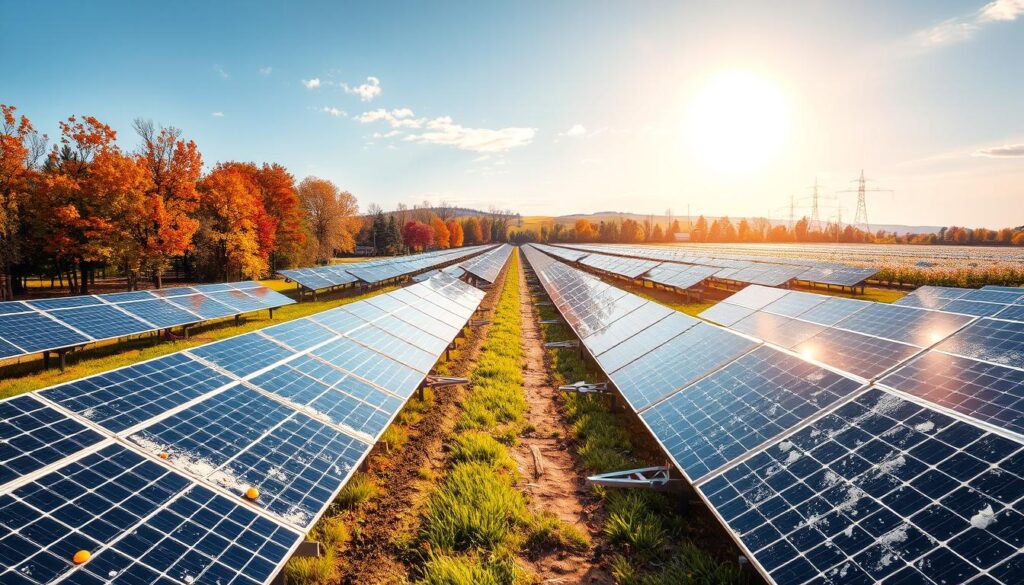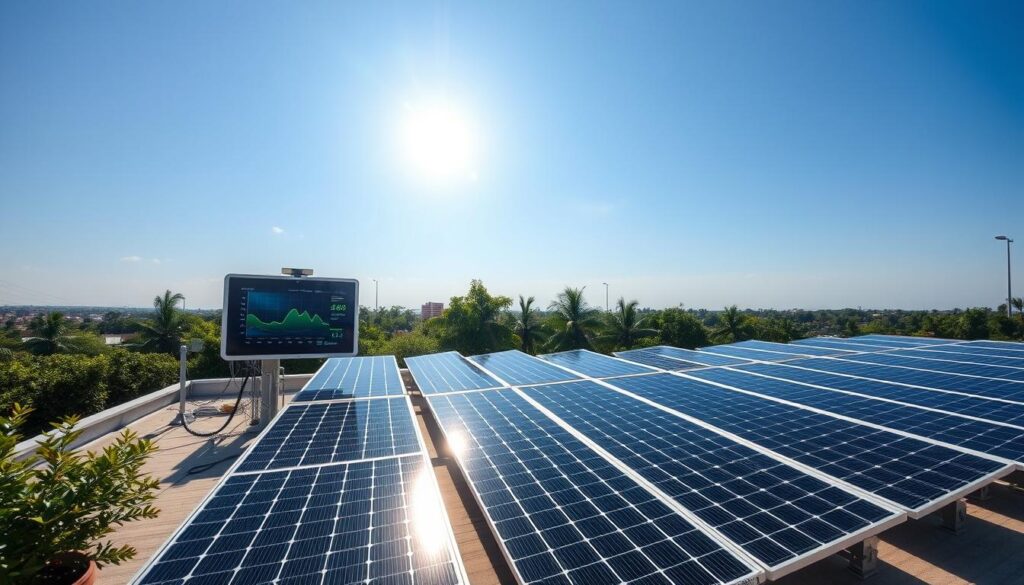As the seasons change, solar panel efficiency can drop.
This is a common problem for solar energy fans and experts. In this article, we’ll show you how to fix these drops and keep your solar energy production high all year.

Key Takeaways
- Understand the factors affecting solar panel performance, including seasonal variations.
- Learn how to monitor solar energy output and track panel efficiency using various tools and techniques.
- Discover solutions for addressing solar panel shading issues that can impact efficiency.
- Implement best practices for winter maintenance, such as preventing snow and ice buildup.
- Explore strategies to maximize the lifespan of your solar panels and maintain optimal efficiency.
Understanding Solar Panel Efficiency Fluctuations
Solar panel efficiency can change throughout the year. It’s key to know what causes these changes. By understanding seasonal impacts, we can make our systems work better and keep energy flowing.
Factors Affecting Solar Panel Performance
Several things can change how well solar panels work. Temperature, shading, and weather are big ones. When it gets hot, panels work less well. But, when it’s cold, they work better.
Shading from trees or buildings can also cut down on sunlight. This means less energy for your panels.
Seasonal Variations and Their Impact
Seasonal changes have a big effect on solar panels. In summer, the heat and more sunlight can make panels less efficient. But, in spring and fall, the cooler weather and more daylight help panels work better.
Winter brings its own challenges. Snow and ice on panels block sunlight, cutting down energy production. Keeping panels clean is crucial in winter.
Knowing how seasons affect solar panels is important. By understanding these changes and taking steps to manage them, we can keep our panels working well all year.
“Proper maintenance and monitoring of solar panels can help mitigate the impact of seasonal efficiency drops and ensure consistent energy production.”
How to Diagnose and Fix Seasonal Drops in Solar Panel Efficiency
It’s important to tackle seasonal efficiency drops in solar panels to get the most out of them. By using a step-by-step method, you can find out why efficiency goes down and fix it. This way, your panels will work at their best again.
Here’s how to tackle seasonal drops in solar panel efficiency:
- Monitor Solar Energy Output: Keep an eye on your solar energy output to spot drops in performance. This will show you when and why efficiency goes down.
- Inspect for Shading and Debris: Look at your solar panels for any blockages. Things like trees, buildings, or dirt can stop them from getting sunlight and making electricity.
- Check for Degradation and Damage: Look for signs of wear and tear on your panels. Cracks, color changes, or peeling can happen due to the weather and affect how well they work.
- Optimize Panel Tilt and Orientation: Make sure your panels are set up right to catch the most sunlight. Changing their angle can help them handle seasonal changes better.
- Perform Routine Maintenance: Clean and maintain your panels regularly. This keeps them working well and stops efficiency from dropping.
By tackling these issues, you can fix seasonal drops in solar panel efficiency. This ensures your renewable energy system runs smoothly all year.

“Maintaining peak solar panel efficiency is crucial for maximizing the benefits of your renewable energy investment.”
Monitoring Solar Energy Output
Keeping an eye on your solar energy output is key to keeping your system running well. By tracking your solar energy, you can spot any changes or drops in performance. This helps make sure your investment keeps giving you the best results.
Tools and Techniques for Tracking Performance
There are many ways to track your solar energy output. Some top choices include:
- Solar monitoring devices: These gadgets are set up with your solar panels. They give you live data on how much energy you’re making, helping you catch any solar energy output monitoring issues.
- Online monitoring platforms: Many solar companies offer websites or apps. They let you see how your system is doing from anywhere.
- Manual meter readings: Taking regular readings from your solar inverter or net meter can give you important info on how your system is performing over time.
Using these tools and methods, you can really understand how much solar energy you’re making. This knowledge helps you make smart choices about keeping your system running smoothly.
“Consistent solar energy output monitoring is the key to maximizing the long-term benefits of your solar investment.”

Remember, watching your solar energy output closely is vital for your system’s efficiency and dependability. By being proactive and fixing any problems, you can keep your renewable energy investment working well for years.
Addressing Solar Panel Shading Issues
Shading can greatly reduce solar panel efficiency, especially in certain seasons. To tackle this, it’s crucial to find and solve shading problems. This section will look at ways to address shading issues and keep solar panels working well.
Identifying Shading Patterns
First, we need to find out where and when shading happens. We can do this by watching the panels, using special tools, or asking experts.
Implementing Shading Mitigation Techniques
After spotting shading patterns, we can use several methods to lessen its effect. These include:
- Trimming or removing nearby trees and vegetation that cast shadows on the panels
- Repositioning or adjusting the angle of the solar panels to minimize shading
- Installing solar tracking systems that automatically adjust the panel orientation to optimize energy generation
- Using micro-inverters or power optimizers to minimize the impact of partial shading on individual solar cells
Solar Panel Cleaning and Maintenance
Keeping solar panels clean is also key to solving shading problems. Dirt, debris, and bird droppings can block sunlight. Regular cleaning with soft brushes or professional services helps panels work better.
| Shading Mitigation Technique | Effectiveness | Cost | Complexity |
|---|---|---|---|
| Vegetation Trimming | High | Low | Low |
| Panel Repositioning | High | Moderate | Moderate |
| Solar Tracking Systems | Very High | High | High |
| Micro-inverters/Power Optimizers | High | Moderate | Moderate |
| Regular Panel Cleaning | Moderate | Low | Low |
By using these solar panel shading solutions, we can reduce shading’s impact. This keeps solar energy systems running well all year.
“Optimizing solar panel efficiency through effective shading management is key to maximizing the return on investment in renewable energy.”
Solar Panel Winter Maintenance
As winter comes, it’s key to keep your solar panels in top shape. This ensures they work well. Taking care of them in winter helps them last longer and work better.
Preventing Snow and Ice Buildup
Winter brings snow and ice, which can block sunlight from your panels. This cuts down on energy production. Here are some ways to fight this:
- Use panel tilt mechanisms or mounts that let panels adjust angles. This helps snow and ice fall off.
- Think about adding heating elements or thermal de-icing systems. They keep snow and ice from sticking.
- Check your panels often and remove snow or ice gently. Use soft brushes or water sprays to avoid damage.
Cleaning and Inspection Procedures
Keeping your panels clean is also vital in winter. Dirt, debris, and salt can block sunlight. Here’s how to keep them clean:
- Set up regular cleaning times. Use soft brushes or gentle water sprays to clean off dirt.
- Look for any damage like cracks or chips on the panels.
- Check the electrical parts and wiring. Make sure they’re safe from the weather.
- Make sure the mounting hardware is secure and not damaged by winter.
By keeping up with solar panel care in winter, you ensure they keep working well. This is true even when the weather is tough.
Maximizing Solar Panel Lifespan
By following the tips in this article, you can keep your solar panels working well. The secret to a long-lasting solar panel is regular care, watching for problems, and fixing them early. This way, your panels will last longer and work better.
Solar panels lose about 0.5% to 1% of their power each year. This can be due to weather, how well they were installed, and how well you take care of them. But, with the right steps, you can slow down this loss. Keeping them clean, making sure they’re not shaded, and fixing any damage can help a lot.
Even a 10-year-old solar panel can still work well, keeping about 80-90% of its original power. With good care, your panels can stay efficient for a long time. By following the best practices, you’ll get the most from your solar energy system.
FAQ
How much do solar panels lose efficiency per year?
Solar panels lose about 0.5% to 1% of their efficiency yearly. This depends on the panel’s quality, how they’re installed, and the environment. Top-notch panels might lose less efficiency over time.
At what temperature do solar panels lose efficiency?
Solar panels lose efficiency as temperatures rise. They work best at 25°C (77°F). Every 1°C (1.8°F) above this, their efficiency drops by about 0.5%.
How much efficiency do solar panels lose in the winter?
In winter, solar panels lose a lot of efficiency. This is due to cold temperatures, more clouds, and snow or ice. They might work 10-25% less than in summer.
How efficient are 10-year-old solar panels?
After 10 years, top-quality solar panels still work at 80-90% of their original level. But, efficiency can vary. It depends on the panel’s quality, installation, and maintenance.
How can I address solar efficiency drops?
To fix solar efficiency drops, monitor your system’s output regularly. Also, deal with shading, maintain your panels in winter, and think about upgrading or replacing old panels.
How can I monitor my solar energy output?
You can track your solar energy output with tools like on-site systems, online platforms, and meter readings. This helps spot drops in efficiency and improve your system’s performance.
How can I address solar panel shading issues?
To solve shading problems, trim trees, move panels, use tracking systems, or clean panels. Regular cleaning removes debris and dust, helping panels work better.
What are the best practices for solar panel winter maintenance?
Good winter maintenance for solar panels includes removing snow and ice, checking for damage, and cleaning panels. Also, make sure panels aren’t shaded by debris or other things.









